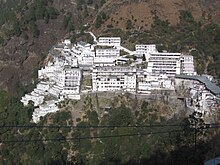
Back শক্তিপীঠ Bengali/Bangla Shakti Peetha Danish Shakti Pitha French शक्तिपिठां GOM शक्ति पीठ Hindi ಶಕ್ತಿ ಪೀಠಗಳು Kannada शक्तीपीठ MAI ശക്തി പീഠങ്ങൾ Malayalam शक्तिपीठे Marathi शक्तिपीठ Nepali
This article has multiple issues. Please help improve it or discuss these issues on the talk page. (Learn how and when to remove these messages)
|
| Part of a series on |
| Shaktism |
|---|
 |
|
|
The Shakta pithas, Shakti pithas or Sati pithas (Sanskrit: शाक्त पीठ, Śakta Pīṭha, seats of Shakti[1]) are significant shrines and pilgrimage destinations in Shaktism, the mother goddess denomination in Hinduism. The shrines are dedicated to various forms of Adi Shakti. [a] Various Puranas such as Srimad Devi Bhagavatam state the existence of a varying number of 51, 52, 64 and 108 Shakta pithas[2][3] of which 18 are named as Astadasha Maha (major) in medieval Hindu texts.[2]

Legends abound about how the Shakta pithas came into existence. The most popular is based on the story of the death of Sati, a deity according to Hinduism. Shiva carried Sati's body, reminiscing about their moments as a couple, and roamed around the universe with it. Vishnu cut her body into 51 body parts, using his Sudarshana Chakra, which fell on earth to become sacred sites where all the people can pay homage to the goddess. To complete this task, Shiva took the form of Bhairava.

Most of these historic places of goddess worship are in India, but there are seven in Bangladesh, four in Nepal, two in Pakistan, and one each in Tibet, Sri Lanka[3] and Bhutan.[6] There were many legends in ancient and modern sources that document this evidence. A consensus view on the number and location of the precise sites where goddess Sati's corpse fell is lacking, although certain sites are more well-regarded than others.

Maximum number of Shaktipeeths are present in the Bengal region. During partition the numbers were West Bengal (18, 1 disputed as Shrinkhala Devi Temple) and Bangladesh (7). After the secret transfer of Dhakeshwari Shaktipeeth to Kolkata the numbers stand as West Bengal (19,1 disputed Shrinkhala Devi Temple) and Bangladesh (6).
- ^ Fuller, Christopher John (2004). The Camphor Flame: Popular Hinduism and Society in India. Princeton: Princeton University Press. p. 44. ISBN 978-0-691-12048-5. Archived from the original on 2017-02-15. Retrieved 2016-10-23.
- ^ a b Vanamali (2008). Shakti: Realm of the Divine Mother. Inner Traditions. pp. 83–84, 143–144. ISBN 978-1-59477-785-1. Archived from the original on 2016-04-29. Retrieved 2016-10-23.
- ^ a b Kunal Chakrabarti; Shubhra Chakrabarti (2013). Historical Dictionary of the Bengalis. Scarecrow. p. 430. ISBN 978-0-8108-8024-5. Archived from the original on 2017-02-15. Retrieved 2016-10-23.
- ^ "Everything you wanted to know about visiting Vaishno Devi". India Times. 5 April 2019. Archived from the original on 13 April 2022. Retrieved 30 June 2022.
- ^ "Mata Hinglaj Yatra: To Hingol, a pilgrimage to reincarnation". tribune.com.pk. 19 April 2016. Archived from the original on 20 March 2022. Retrieved 15 November 2019.
- ^ "Significance of Bhairab Kunda Temple in Bhutan". Kuensel Online. Retrieved 2023-04-02.
Cite error: There are <ref group=lower-alpha> tags or {{efn}} templates on this page, but the references will not show without a {{reflist|group=lower-alpha}} template or {{notelist}} template (see the help page).